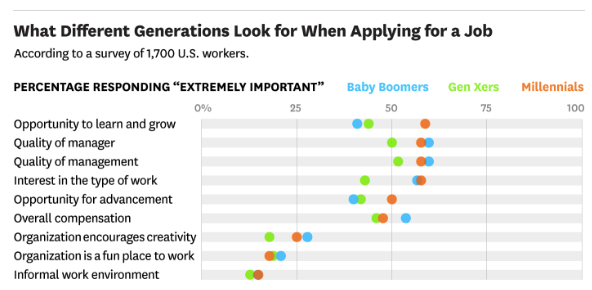
Whether you’re Google, or “the next Uber-for…”, a multi-national corporation or an agile start-up, money may make the world go-round, but it’s talent that will make your company thrive, take it to the next level, and help you reach the customers who need your products or services.
But how can your company compete with the likes of Google, Apple and Oracle? Even if you’re not in the tech industry, your company still likely relies heavily on IT services – and that means you’re still competing for IT talent.
The key to winning the talent war is to look at it as a long term strategy: one that’s won with calculated, methodical processes – Processes that the “giants” might have perfected – but that anyone can use.
Get a free assessment of your recruitment needs
Contact us1- Take a Good, Hard Look at Your Brand …
Because you know your potential candidates are going to. While this might feel like a “marketing” tactic – the same philosophy applies to hiring.
“Look at the type of people you want to hire” Miriam Groom, vice president of sales and marketing for Groom & Associates, suggests. “Where would they want to work? Your brand needs to be appealing to not just future customers, but future employees as well.”
That means paying attention to how you are represented in the media as an employer – rather than just as a purveyor of products and services.
A Gallup poll recently found that Millennials, as the largest generation in the workforce today, are consumer of employment opportunities just as much as they are consumers for your products. Is your brand one they would want to work for?
Potential employees glean information about your workplace from a lot of sources. For example, ecommerce giant, Amazon, is renown for its online shopping empire and vast business operations. However, a New York Times article also called into question its “aggressive workplace culture.”
“A key employment ‘branding message’ employers should remember is that while all employees want an opportunity to learn and grow, and are looking for strong managers, these things are slightly more important to Millennials,” Groom suggests.

Graphic credit: Gallup via HBR.com
2- Make Recruiting Job 1. Really.
Make finding and keeping the best people your company’s top priority – not just a slogan in an annual report, says Groom. “Hiring the best people has to be everyone’s priority. It’s just too important to your company’s future to leave it to a few people in HR – no matter how good those HR people are.”
Whether that’s involving key executives in meeting new hires, or arranging coffee for a potential recruit and a lead on a key project, make sure everyone in your company understands that everyone is there to help find and groom the next generation of recruits
3- Examine Your Management.
Again, Gallup points to the importance of quality management and strong managers as common concerns for all generations – but think about your managers from an employee’s perspective. “If you have managers – or a culture — who are known for burning out employees, sucking them dry and then tossing them aside, that’s a climate that’s going to give any candidate pause,” Groom said.
4- Think holistically about your brand presence.
Most candidates – but especially Millennials and Generation Z – are far more plugged in to social media and are more likely follow brands. Do more than just post about your latest company news, big wins, or job openings. Share news or trends that are affecting your company or industry. Share news about your people – not just executives. Create a whole company that your employees will want to be ambassadors for.
5- Create a “Dream Team” List – with a Deep Bench.
Groom also suggests taking a long-term approach to some hiring: Take time to engage with potential candidates you’d love to hire – before they ever jump into the candidate pool.
“Every company should have a ‘go to list’ of people in various types of roles (ie: programmers, marketing, sales, etc) who are stars in their own right. Get to know them: Follow them on social media. Engage them on Linked In. Anyone can prepare to answer questions well for an interview – even a few days of interviews. But you’ll really get to know the real person if you engage with them over time.”
Again, this is a slight shift in perspective. “As companies we’re used to thinking about the customer journey, but as employers, we have to remember there is an employee journey that’s just as important… because our employees create the companies, products and experiences our customers want. That means they’re no less important.”
So how do you create this “magical” list of dream team potential employees? Just like it takes multiple types of marketing efforts to reach, persuade and ultimately win a customer – it takes a multi-pronged attack.
One way is to start young. College recruiting isn’t anything new. But when you don’t have budgets to offer six figure signing bonuses like Facebook, or the cache of Apple, you may have to think outside the box.
Start up tech firm, Thumbtack, for example, approaches its university recruiting/presence as a year-round strategy, with established relationships and presence with a handful of universities.
“Get involved with good college programs – and it doesn’t have to be just MIT or Stanford. Get to know other university’s programs and create a real relationship or presence on the campus,” Groom suggests by not just participating in career fairs or hackathons, but by also getting more deeply involved in the program through employer panels, guest speakers, experiential activities/class projects, or, of course, internships… Places that don’t always require executives, but rather well-prepared, key people from your management team who also might be rising stars.
“You’ll build exposure for your brand as an employer and thought leader on the campus, and create relationships with the students over time – during which you’ll get to know them in all sorts of situations… That’s valuable insight when it comes hiring time.”
Also, use your existing employees. If you use entrepreneur and author Jim Rohn’s old adage that a person is the average of their five closest friends, then it’s a good chance that your best employees already know a few people who would be stellar new hires. Both Facebook’s Ninja Hunt and Google’s “Sourcing Jam” capitalize this philosophy, and based on their research that their employees were their best sources for potential employees.
6- It’s More than Just Money.
Yes, compensation is important – and so are the “softer” benefits like telework, on-site child care or free, chef-inspired lunchrooms, but they’re not all that top employees are going to consider, and what they value can change depending on where they are at in their personal and professional lives.
But if you’re a small firm, make that your advantage by personally communicating to your hires with customized messaging, contacts from key leaders and executives. While a big brand may represent stability to some employees, a small firm represents access to leadership and influence across the business – an important differentiator to employees hungry to make a difference.
“Make hiring personal,” Groom says, referring to an old story about a West Coast tech firm aggressively trying to recruit a computer programmer from the East Coast. The programmer declined the firm’s generous offer because he didn’t see a thriving community for his family’s faith, and his faith was very important to him and his wife. The tech firm regrouped, flew his family out with him on a second trip, and took the programmer’s wife around to meet members of their faith’s community.
“There is no, one silver bullet in this day and age of hiring,” Groom says. “You have to have an arsenal – a whole array of tactics and benefits – if you want to compete and win at recruiting the best people for your company.”
7- Last, Don’t Forget to Measure.
You expect efficiencies from the rest of your organization. Recruiting really is no different. Just like your sales organization tracks a potential sales lead through the funnel, track your own hiring process from the point of identifying a potential employee, through the hiring process, to tendering an offer or first day of employment.
At the core of this exercise is understanding what’s working, as Linked In did by studying their own processes. Review who’s been successful at green-lighting the hires who eventually became stellar employees? How long does it take to close a potential hire? And are there any road blocks you can remove? From executives who are constantly rescheduling interviews to a manager who may just not see the importance of the process – when you’re in the home stretch, trying to hire that key role, make sure your processes are in place.
“You won’t always get your ideal candidate on the first try, either. I’ve seen companies like Apple target specific industry experts – and not get to hire that person until the third or fourth attempt,” Groom says. “But if the person is right for the job and right for the company – they never ‘go away.’ Remember the old fundraising saying: a ‘no’ is just a slow yes.”
